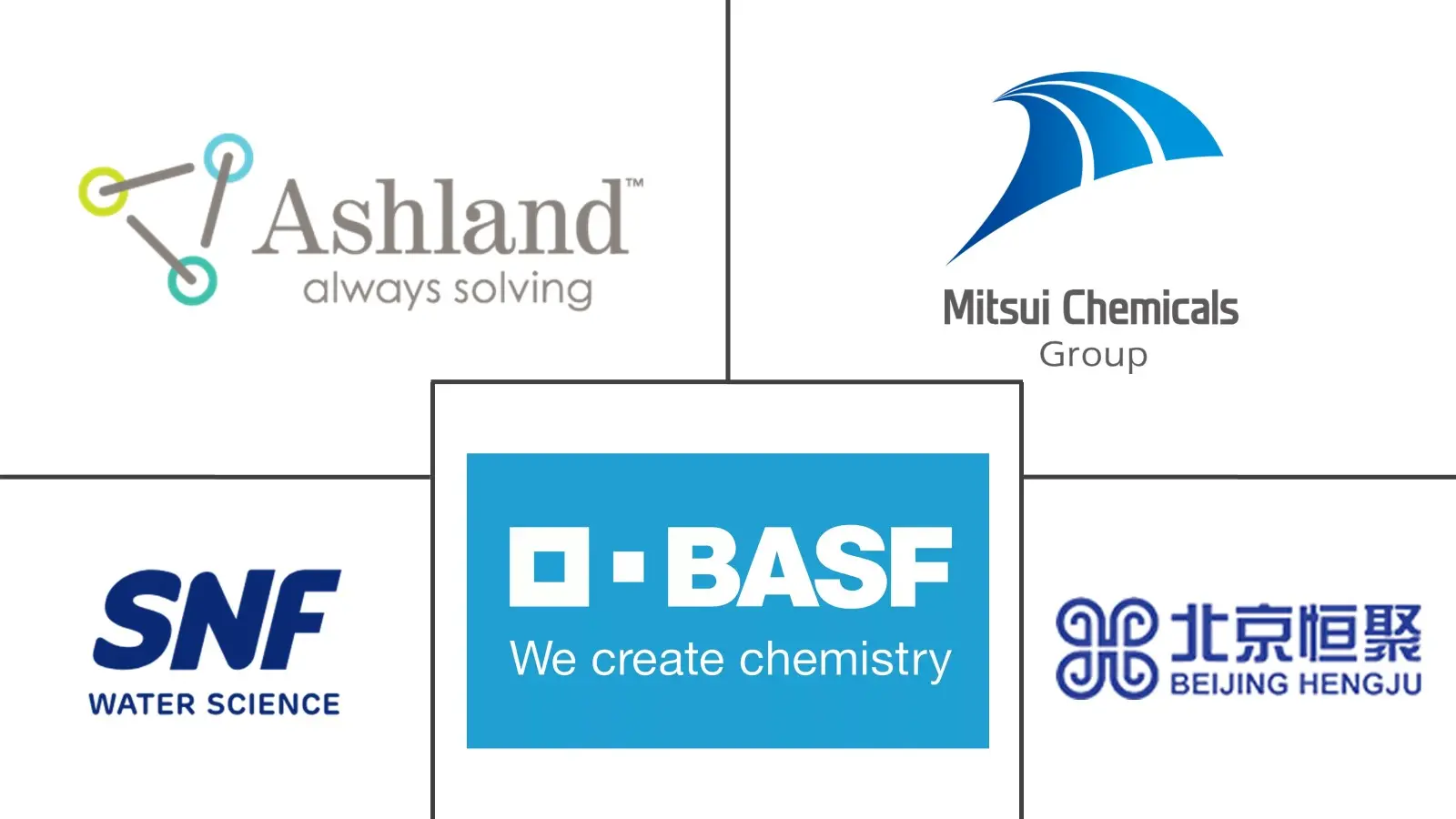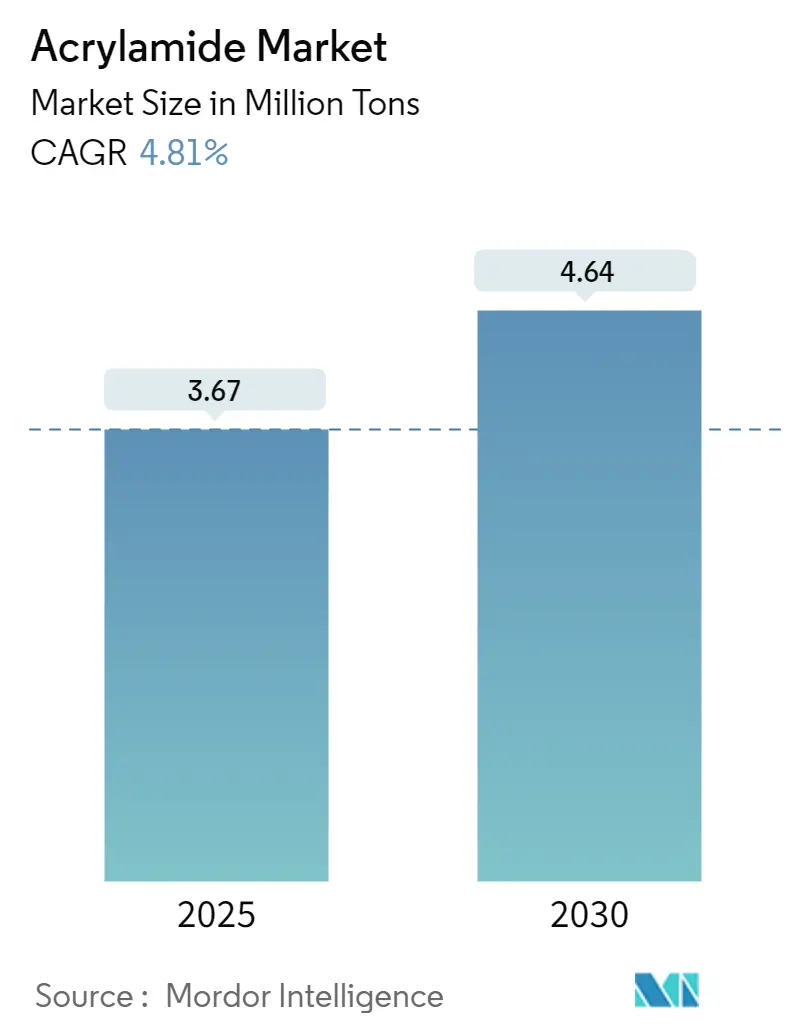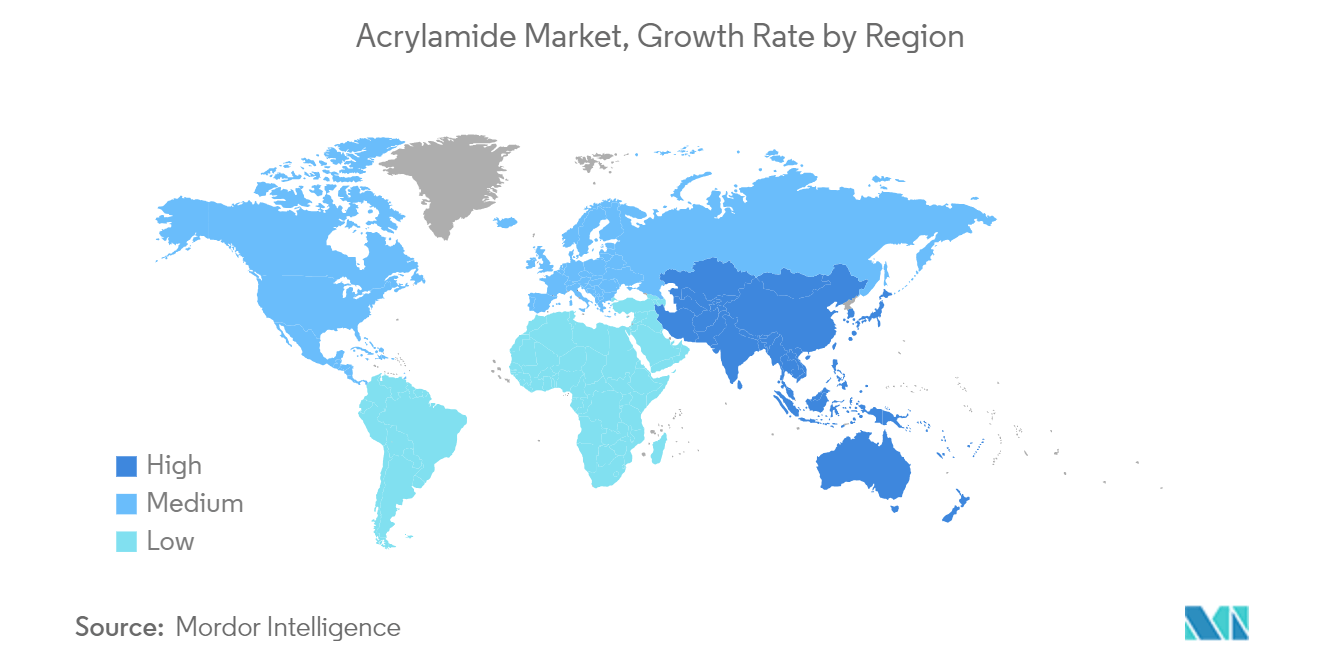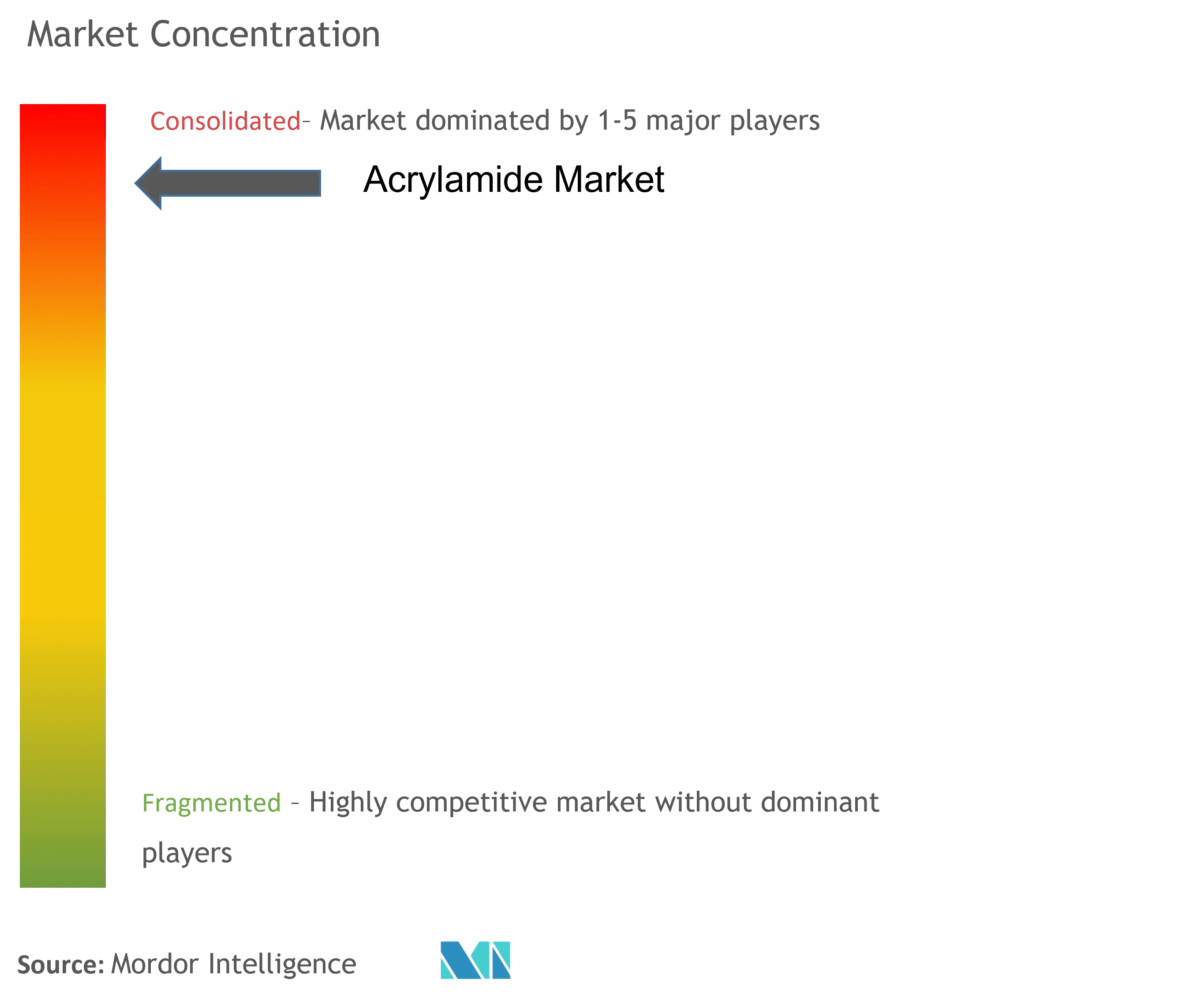Acrylamide Market Analysis
The Acrylamide Market size is estimated at 3.67 million tons in 2025, and is expected to reach 4.64 million tons by 2030, at a CAGR of 4.81% during the forecast period (2025-2030).
The COVID-19 pandemic impacted the market negatively in 2020. Owing to the pandemic, several countries worldwide witnessed lockdowns to help curb the spread of the virus. This completely disrupted the supply and demand chain, which negatively affected the market. The market later recovered and began growing at a significant rate.
- The market is expected to grow in the short term because of the growing demand for enhanced oil recovery (EOR) processes, which use a lot of polyacrylamides. In the long run, the market may grow because of strict European water regulations, which use a lot of acrylamide in water treatment.
- However, acrylamide is obtained through interactions with heated meals and cigarette smoke. The unfavorable health impacts of this exposure are projected to be a significant hurdle for the worldwide acrylamide industry.
- Growing investments in water treatment in countries like China are expected to create immense opportunities for market growth.
- Asia-Pacific accounted for a significant market share, followed by North America and Europe.
Acrylamide Market Trends
Water Treatment Application to Dominate the Market
- Acrylamide is a linear polymer made up of monomer units with amide groups that stick to particles on the surface. The extensive polymer chain connects these particles. This process is called flocculation and is widely used in wastewater treatment methods.
- When aqueous acrylamide or polyacrylamide (PAM) solutions are mixed with sewage, they form larger flocs, which can improve sedimentation rates in clarifiers, floatation rates in dissolved air flotation (DAF) systems, and water removal in sludge thickening equipment. Polyacrylamide is used a lot in industries like treating sewage, making pulp and paper, chemicals, petrochemicals, textiles, oil sands, and mining.
- The increased industrial demand for water has been a primary driver of the water treatment industry's strong growth. As water is utilized in huge quantities in numerous industries, such as power, steel, mining and metallurgy, petrochemicals, oil and gas, food and beverage, and textiles and dyes, governments across the world are implementing regulations related to wastewater treatment in these industries before releasing the water back into the environment.
- In sewage treatment, non-ionic polyacrylamide is preferred over its alternatives if the sewage system is acidic in nature. Furthermore, the inorganic flocculant poly-aluminum or aluminum sulfate provides better performance in the water treatment process.
- Cationic polyacrylamide is highly soluble in water and has an excellent flocculation effect. It is used in a variety of applications, including urban sewage treatment, paper making, metallurgical and petrochemical processing, food processing, dyeing, miner dressing, and industrial wastewater treatment.
- The Northeast Water Purification Plant (NEWPP) Expansion Phase 2 in Texas, United States; the Bull Run Filtration Project in Oregon, United States; the Reconstruction Project of Linville Water Treatment Plant in Southeast Queensland, Australia; etc., are some of the upcoming projects that may impact the demand for polymer.
- The Northeast Water Purification Plant (NEWPP) Expansion Project of the City of Houston is a design-build project that will increase the capacity of the existing water plant by 400 million gallons per day (MGD) by 2025. The project will enable the city and regional water agencies to satisfy predicted demand, according to Houston Public Media.
- Hence, with such projects expected to come online, the demand for acrylamide is likely to increase for water treatment applications during the forecast period.
Asia-Pacific Region to Dominate the Market
- Asia-Pacific is predicted to increase at a modest rate throughout the projection period. Increasing disposable income in emerging nations is driving demand for convenience items, helping the growth of the worldwide acrylamide market. China has the biggest market share and will be the top acrylamide user during the projection period due to fast-growing development.
- For instance, in China, between 2021 and 2025, the cumulative number of development and exploration wells drilled is expected to reach 118,000 because of the country's growing demand for oil and gas.
- As per the National Bureau of Statistics of China, the country spent approximately CNY 3.77 billion (USD 524 million) in 2022 to treat wastewater pollution caused by industrial production. Moreover, by 2025, the industrial wastewater market in China is expected to reach USD 19.4 billion. The country is working on its plans to renovate or build about 80,000 km of sewage collection pipeline networks by 2025.
- In early 2022, China approved new wastewater reuse guidelines, requiring 25% of sewage to be treated to reuse standards by 2025. This reflects the country's aim to shift away from capacity expansion and focus more on treated effluent quality. As part of the project, China aims to construct and refurbish 80,000 km of wastewater collection pipes over the next five years.
- As there is not enough enhanced oil recovery and fracking in the country as in other places, acrylamide is not used as much in the oil and gas industry compared to other areas. On the other hand, Chinese energy giants are making progress by getting natural gas out of shale rock formations.
- The factors listed above are projected to increase the demand in the Asia-Pacific acrylamide market in the future.
Acrylamide Industry Overview
The acrylamide market is consolidated, with a few players occupying the majority of the market share. Major companies (not in any particular order) operating in the market are SNF Group, CNPC, BASF SE, Mitsui Chemical Inc., Beijing Hengju Chemical Group Corporation, and Ashland.
Acrylamide Market Leaders
-
SNF Group
-
BASF SE
-
Mitsui Chemicals, Inc.
-
Beijing Hengju Chemical Group Corporation
-
Ashland
- *Disclaimer: Major Players sorted in no particular order
Acrylamide Market News
- August 2023: Mitsui Chemicals Inc. announced that Polaris Chemicals Inc. had begun production of biocatalysts used in the production of acrylamide.
- November 2022: Kerry released Acryleast Pro, the advanced iteration of the company's signature acrylamide-reducing non-GMO (non-genetically modified) yeast, Acryleast.
- March 2022: Renaissance BioScience was granted new patents for its non-GMO acrylamide-reducing yeast (ARY) in India, China, Australia, Vietnam, and Russia.
Acrylamide Industry Segmentation
Nitrile hydratase's hydrolysis of acrylonitrile results in the chemical compound known as acrylamide. Acrylamide is most commonly employed in industrial operations to produce polyacrylamides, which are water-soluble thickeners. Polyacrylamide accounts for approximately 90% of acrylamide's overall consumption. It is present in cigarette smoke. Acrylamide is formed during the heating of carbohydrates.
The acrylamide market is segmented by application and geography. By application, the market is segmented into flocculants for water treatment, enhanced oil recovery, pulp and paper manufacturing, and other applications (soil conditioning, ore processing, etc.). The report also offers market sizes and forecasts for 27 countries across major regions. For each segment, market sizing and forecasts were done on the basis of volume (tons).
| By Application | Flocculant for Water Treatment | ||
| Pulp and Paper Manufacturing | |||
| Enhanced Oil Recovery | |||
| Other Applications | |||
| By Geography | Asia-Pacific | China | |
| India | |||
| Japan | |||
| South Korea | |||
| Thailand | |||
| Indoneisa | |||
| Vietnam | |||
| Malaysia | |||
| Rest of Asia-Pacific | |||
| North America | United States | ||
| Canada | |||
| Mexico | |||
| Europe | Germany | ||
| United Kingdom | |||
| France | |||
| Italy | |||
| Spain | |||
| NORDIC | |||
| Russia | |||
| Turkey | |||
| Rest of Europe | |||
| South America | Brazil | ||
| Argentina | |||
| Colombia | |||
| Rest of South America | |||
| Middle East and Africa | Saudi Arabia | ||
| South Africa | |||
| United Arab Emirates | |||
| Egypt | |||
| Nigeria | |||
| Qatar | |||
| Rest of Middle East and Africa | |||
Acrylamide Market Research FAQs
How big is the Acrylamide Market?
The Acrylamide Market size is expected to reach 3.67 million tons in 2025 and grow at a CAGR of 4.81% to reach 4.64 million tons by 2030.
What is the current Acrylamide Market size?
In 2025, the Acrylamide Market size is expected to reach 3.67 million tons.
Who are the key players in Acrylamide Market?
SNF Group, BASF SE, Mitsui Chemicals, Inc., Beijing Hengju Chemical Group Corporation and Ashland are the major companies operating in the Acrylamide Market.
Which is the fastest growing region in Acrylamide Market?
North America is estimated to grow at the highest CAGR over the forecast period (2025-2030).
Which region has the biggest share in Acrylamide Market?
In 2025, the Asia-Pacific accounts for the largest market share in Acrylamide Market.
What years does this Acrylamide Market cover, and what was the market size in 2024?
In 2024, the Acrylamide Market size was estimated at 3.49 million tons. The report covers the Acrylamide Market historical market size for years: 2019, 2020, 2021, 2022, 2023 and 2024. The report also forecasts the Acrylamide Market size for years: 2025, 2026, 2027, 2028, 2029 and 2030.
Our Best Selling Reports
Acrylamide Industry Report
Statistics for the 2025 Acrylamide market share, size and revenue growth rate, created by Mordor Intelligence™ Industry Reports. Acrylamide analysis includes a market forecast outlook for 2025 to 2030 and historical overview. Get a sample of this industry analysis as a free report PDF download.







